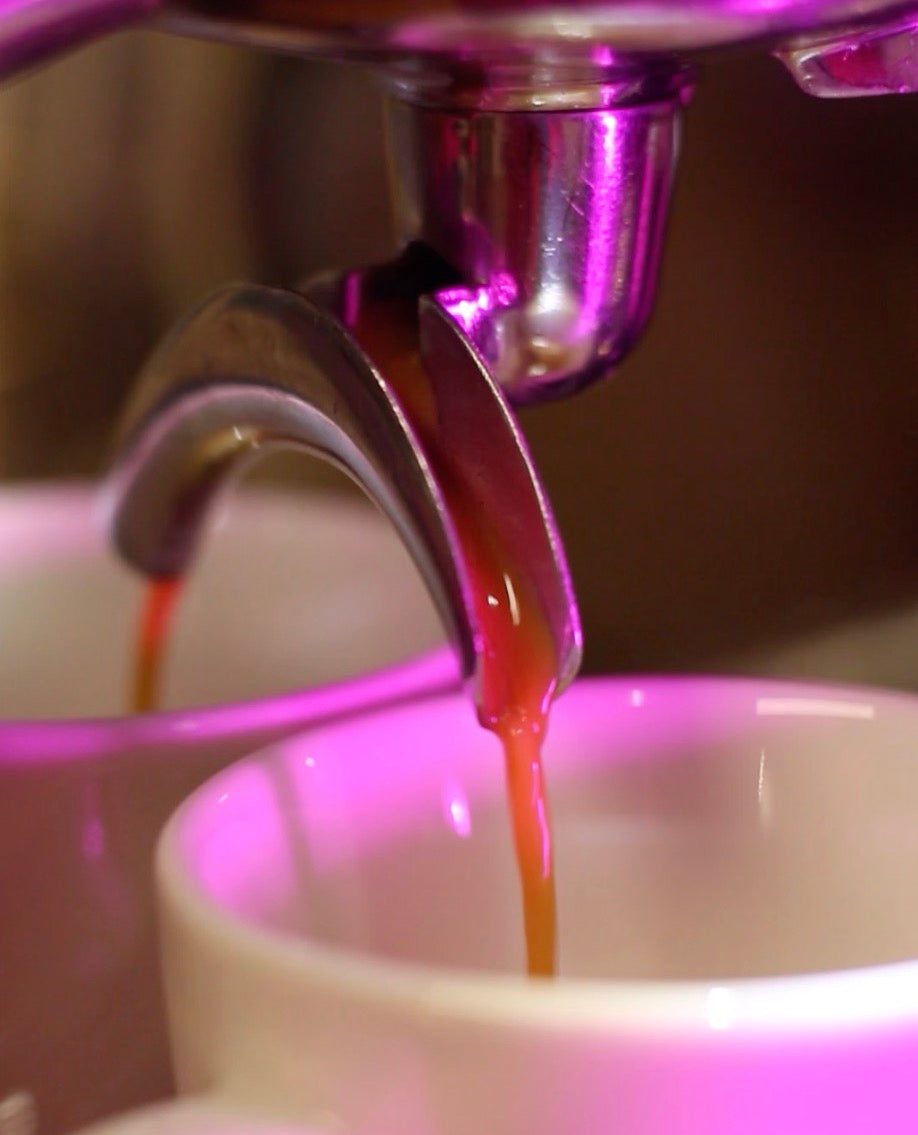Coffee Information
This coffee, which was part of a collaborative release last year, is a new iteration of the experimental processes we have created, in this case, from Gesha husk from Colombia. Here, to avoid repeating information, we will focus a bit more on the additive process. For more detailed information on the coffee, go here .
A subtle, balanced and floral coffee; with a new process. In this new King Solomon experiment —applied to a coffee that we kept frozen and vacuum-sealed for about 6 months—, we explored the effect of coffee husk fermentation on the flavor of the seed.
This coffee, from Finca La Cinta in Colombia, is a washed Wush Wush, imported by Manantial Coffee Chile that we launched in December 2022 together with Café 3 Ciclos . You can find more information about this coffee here .
Based on what we learned in other experiments —such as Lacto-Mango, Lacto-Cherry and Kombu-Watermelon—, we cultured bacteria and yeast using Gesha peel*, from the municipalities of Gigante and Garzón in Colombia; imported by Mitaca Café . Using a 1:5 ratio of peel to water, with 25% sugar and 2% salt, we created an infusion whose aroma was confused with tamarind and natural wine.
Once the aforementioned cultivation is finished, we use it to rehydrate the Wush Wush to 20% humidity, 24 hours before roasting it, following Christopher Feran's rehydration protocol, stabilizing 15 hours before roasting.
The result is a spicy and liquor-like coffee, similar to an extended fermentation honey . With a high sweetness sensation, but slightly dry.
*Coffee husk refers to the fruit or cherry that encases the seeds. It is typically used in producing countries as an ingredient for natural compost-based fertilizers, but has recently been gaining ground as a coffee-derived product in its own right. The fruit infusion tends to have flavors close to peach, tamarind, and panela water; but much of its sensory profile depends on the post-harvest process—just as with the seed.
Producer: La Cinta Farm, Yeferson Olaya.
Country: Colombia.
Region: Tolima, Planadas.
Altitude: 2200 mts.
Variety: Wush Wush.
Post-harvest process: Wet fermentation in mucilage in an anaerobic environment and rehydration with fermented coffee husk infusion.
Harvest: April-June 2021.
Sensory Description
Butter cookies, butterscotch, rum raisins, whiskey, banana chewy, blackberry jam, anise bread.
Balanced medium acidity, complex medium sweetness and low tannic bitterness.
Medium body, creamy texture and a slightly dry finish.
Import
This coffee was purchased directly from Manantial Coffee Chile , who imported the coffee to Chile. The kilo of green coffee cost CLP $26,400 —8.2 times the C price at the time of purchase—. The husk was purchased directly from Mitaca Café , who imported it to Chile; and had a cost of CLP $ 7,468 per kilo. This does not include operating costs, design or packaging —developed in conjunction with @sangre_artificial —.
Roasting
As in all these experiments, the main difficulty in roasting this coffee was managing a sort of comparison point to other roasts in circumstances where color is no longer such a useful tool.
However, using reference curves from other processes—Lacto-Cherry, especially—we aimed for a relatively slow roast, but to a temperature so low that in any other coffee it would have resulted in underdevelopment.
Toaster: Kaffelogic Nano 7.
Load: 90 grams.
Initial humidity: 12.4%, rehydrated to 20%
Total Time: 7 minutes, 45 seconds.
DTR: 20%
Final Temperature: 213 ºC
Accumulated Temperature*: 10.8
Mass loss: 20%

*We calculate this value by dividing the area under the roasting curve by the load, ([ºC x min] / grams). We consider this value, in our roaster, to be a reasonable approximation of the development of the coffee, in a broad sense.
Water
We arrived at all the recipes for this coffee using Aguas Nómade .
However, if you want to get the most out of it, you can use the following water recipe. For this, we recommend using the mineral concentrate recipes made by Barista Hustle .
— 185 ppm** Hardness ( MgSO₄ )
— 38 ppm** Alkalinity or Buffer ( NaHCO₃ )
**As an equivalent in CaCO3.
Preparation
In general, our coffees are designed for high extractions. We recommend fine grinds, higher temperatures, and longer ratios—for filtered, between 1:18 and 1:20; for espresso, between 1:3 and 1:5. In addition, we tend to prefer relatively low concentrations, where we find the greatest clarity in descriptors.
The idea of including recommended recipes is not to prevent you from experimenting with coffee, but to share the recipes with which we have had good results.
Manual percolation coffee makers ( conical or flat bottom, such as V60, Origami, Kalita Wave, Kono, etc.)
Dose: 15 grams.
Water: 250 grams.
Drink: 200-210 grams.
Time : 3 - 5 minutes.
Temperature: Boiling; 97ºC in Santiago.
TDS: 1.5 - 1.6%.
First discharge — saturation or bloom — 50 grams, swirl the pot for 5 seconds making sure all the coffee is wet. Using something like a WDT device also works.
Second pour of 50 grams (100) at 30 seconds. Move the coffee maker gently in circles for 2 seconds.
Third pour of 50 grams (150) just before the water level reaches the coffee. Move the coffee maker gently in circles for 2 seconds.
Pour 50 grams (200) into the fourth cup just before the water level reaches the coffee. Move the coffee maker gently in circles for 2 seconds.
Final pour of 50 grams (250) just before the water level reaches the coffee. Move the coffee maker gently in circles for 2 seconds.
It is recommended to reach something close to these parameters with another coffee first. Try to make all pours from the highest possible height that does not create turbulence on the surface of the water, in a circular motion over the coffee and maintaining a controlled flow. In addition, it is recommended to keep the water boiling between pours.
For something like a Kalita Wave , I recommend using a metal mesh underneath the paper filter, to prevent it from sticking to the machine and decreasing flow.
Immersion coffee makers (such as AeroPress, French Press, Hario Switch, Clever, etc.)
Dose: 15 grams.
Water: 240 grams.
Drink: 210-215 grams.
Time: 8 - 9 minutes.
Temperature: Boiling; 97ºC in Santiago
TDS: 1.3 - 1.4%
[Standard method.]
Pour the 240 grams of water over the coffee, trying to pour from as high as possible so as not to create turbulence on the surface of the water, and making sure to wet all the coffee evenly. Stir if necessary so that all the coffee is wet.
Insert the plunger without applying pressure to create a vacuum.
After 4 minutes, with the plunger still inserted, gently move the brewer in circles for 5 seconds.
At 7-8 minutes, begin to press the plunger very gently, pushing past the sound of air.
This recipe is recommended if you don't have a high-end grinder, as it allows you to brew with a lot of room for error. It is recommended to first get close to these parameters with another coffee, and use the finest grind that makes it easy to press the plunger gently.
Additionally, you can use this recipe for methods like Clever or the Hario Switch , in which case we recommend pouring the water before adding the coffee.
Espresso
Dose: 15 grams.
Water: The water you use in your espresso machine, or the suggested recipe, if you have a machine that allows it easily.
Drink: 40-45 grams.
Time: 15-20 seconds.
Pressure from pump: 6 bar
Temperature: 96-97ºC
TDS: 7 - 8%
It is recommended to previously reach something close to these parameters with another coffee. For something like a allongé , use the same parameters, but aim for a 75-90 gram drink. For something like a coffee shot , lower the temperature to 93-95°C, and grind more coarsely, aiming for a 200 gram drink in about 50-60 seconds.
As an additional fact, this coffee in a drink with milk greatly enhances that butterscotch flavor, highly recommended.
Zero bypass coffee makers (Tricolate, LVL-10 and Pulsar)
Dose: 10 grams.
Water: 170 grams, recipe included.
Drink: 165 - 175 grams.
Time: 4-6 minutes.
Temperature: Boiling; 97ºC in Santiago
TDS: 1.3 - 1.5%
[Tricolate]
First pour —saturation or bloom— of 30 grams, move the coffee maker for 10 seconds ensuring that all the coffee is wet or stir carefully with WDT tool.
Pour the remaining 140 grams (170) in 5-6 pulses, trying to keep the water level between 1-1.5 centimeters above the coffee. Move the coffee maker gently in circles for 3 seconds after each pulse.
For the Next Level LVL-10, use 30 grams of coffee to 510 grams of water, with a slightly coarser grind; for the Pulsar, use between 20-25 grams of dosage and maintain the ratio.
For other zero-bypass coffee makers, keep the proportions but use the dosage recommended by the manufacturer. Try to do everything on a surface that allows you to keep the coffee maker level. It is recommended to reach something close to these parameters first with another coffee. In addition, it is recommended to keep the water boiling between pours.
Music
All of our coffees also come with a Spotify playlist, featuring songs we like to listen to while brewing and drinking. Generally, the songs we include in each playlist relate to some sensory aspect of coffee; but explaining exactly how they relate goes beyond words.
Listen to Wush Wush Cáscara on Spotify


